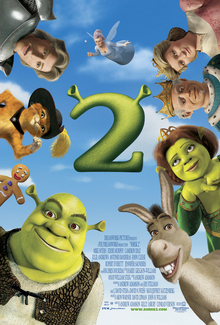
Back شريك 2 Arabic Şrek 2 Azerbaijani Шрэк 2 Byelorussian Шрек 2 Bulgarian Shrek 2 Catalan Шрек 2 CE Shrek 2 CEB شڕێک ٢ CKB Shrek 2 Czech Shrek 2 Welsh
| Shrek 2 | |
|---|---|
 Theatrical release poster | |
| Directed by | |
| Screenplay by |
|
| Story by | Andrew Adamson |
| Based on | Shrek! by William Steig |
| Produced by |
|
| Starring | |
| Edited by |
|
| Music by | Harry Gregson-Williams |
Production companies | |
| Distributed by | DreamWorks Pictures (through DreamWorks Distribution)[1][2] |
Release dates |
|
Running time | 92 minutes[3] |
| Country | United States[1] |
| Language | English |
| Budget | $150 million[2] |
| Box office | $935.5 million[4] |
Shrek 2 is a 2004 American animated fantasy comedy film loosely based on the 1990 children's picture book Shrek! by William Steig. Directed by Andrew Adamson, Kelly Asbury, and Conrad Vernon from a screenplay by Adamson, Joe Stillman, and the writing team of J. David Stem and David N. Weiss, it is the sequel to Shrek (2001) and the second installment in the Shrek film series. The film stars Mike Myers, Eddie Murphy, and Cameron Diaz, who reprise their respective voice roles of Shrek, Donkey, and Princess Fiona. They are joined by new characters voiced by Antonio Banderas, Julie Andrews, John Cleese, Rupert Everett, and Jennifer Saunders. Shrek 2 takes place following the events of the first film, with Shrek and Donkey meeting Fiona's parents as the zealous Fairy Godmother, who wants Fiona to marry her son Prince Charming, plots to destroy Shrek and Fiona's marriage. Shrek and Donkey team up with a sword-wielding cat named Puss in Boots to foil her plans.
Development began in 2001, and following disagreements with producers, the first film's screenwriters Ted Elliott and Terry Rossio were replaced with Adamson. The story was inspired by Guess Who's Coming to Dinner (1967), and new animation tools were utilized to improve the visual appearance of each character, particularly Puss in Boots. The lead actors also received a significant bump in salary to $10 million, which at the time was among the highest contracts in their respective careers. Like its predecessor, Shrek 2 also parodies other films based on fairy tales and features references to American popular culture.[5][6][7] The film is dedicated to the memory of Shrek creator William Steig, who died on October 3, 2003, eight months before the film was released.
Shrek 2 premiered at the 2004 Cannes Film Festival on May 15, 2004, where it competed for the Palme d'Or, and was released in theaters on May 19, by DreamWorks Pictures. Like its predecessor, it received positive reviews from critics and is considered by many to be one of the best sequel films ever made.[8][9][10][11] The film grossed $935 million worldwide. It scored the second-largest three-day opening weekend in United States history and the largest opening for an animated film at the time of its release.[12][13] It went on to become the highest-grossing film of 2004[14] and the fourth-highest-grossing film overall at the time of its release. Shrek 2 is also DreamWorks Animation's highest-grossing film to date and the highest-grossing film released by DreamWorks Pictures, and it held the title of being the highest-grossing animated film of all time worldwide until Pixar Animation Studios' Toy Story 3 surpassed it in 2010.[15] The film received two Academy Award nominations for Best Animated Feature and Best Original Song, and its associated soundtrack charted in the Top 10 on the US Billboard 200. Two sequels—Shrek the Third (2007) and Shrek Forever After (2010)—had soon followed. The film's character Puss in Boots has also received his own series of spin-off media—Puss in Boots (2011), The Adventures of Puss in Boots (2015–2018) and Puss in Boots: The Last Wish (2022)—following his debut.
- ^ a b c d "Shrek 2 (2004)". AFI Catalog of Feature Films. Archived from the original on January 4, 2018. Retrieved January 3, 2018.
- ^ a b Cite error: The named reference
BOMwas invoked but never defined (see the help page). - ^ "Shrek 2 (PG)". British Board of Film Classification. May 26, 2004. Archived from the original on February 7, 2015. Retrieved September 4, 2014.
- ^ "Shrek 2 (2004) - Financial Information". The Numbers. Retrieved January 29, 2023.
- ^ Sharma, Devansh (June 30, 2020). "Remembering Shrek 2: How Kelly Asbury and team played around with the idea of a subversive Disney fairy tale". Firstpost. Archived from the original on August 19, 2020. Retrieved August 13, 2020.
- ^ Anderton, Ethan (January 25, 2017). "You May Have Forgotten How Many Movies 'Shrek' Parodied". Slashfilm. Archived from the original on January 16, 2021. Retrieved August 13, 2020.
- ^ Ross, Dalton (November 5, 2004). "Shrek 2". Entertainment Weekly. Archived from the original on December 5, 2017. Retrieved August 13, 2020.
- ^ "The 10 best movie sequels of all time". GQ. February 22, 2024. Retrieved February 22, 2024.
- ^ "5 Reasons Why Shrek 2 Is One Of The Best Sequels Of Our Time". Fandomwire. August 20, 2023. Retrieved August 20, 2023.
- ^ "Why Shrek 2 Is a Perfect Sequel". CBR. March 13, 2022. Retrieved March 13, 2022.
- ^ "Shrek 2 Actually Holds Up Much Better Than the Original and Here's Why". Movieweb. April 13, 2024. Retrieved April 13, 2024.
- ^ Gray, Brandon (May 24, 2004). "'Shrek 2' Lands Far, Far Ahead of Summer Pack". Box Office Mojo. Archived from the original on November 5, 2013. Retrieved March 24, 2012.
- ^ "Box Office History for Digital Animation Movies". The Numbers. Archived from the original on June 10, 2013. Retrieved March 24, 2012.
- ^ "2004 DOMESTIC GROSSES". Box Office Mojo. Archived from the original on April 25, 2013. Retrieved March 24, 2012.
- ^ Cite error: The named reference
EWTS3Highestwas invoked but never defined (see the help page).